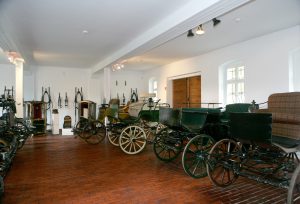Carriage house and located on the opposite side of the courtyard stables, are important parts of Raczyńscy residence in Rogalin. Originally wooden, and from 1801 bricked buildings were erected in 1776, ie shortly after the completion of the work at the palace. This was due to not only for performance, but also prestigious reasons. Almost to the end of the eighteenth century ceremonial teams, ie specially selected horses, ornate carriages and service in appropriate attire, were in fact an important part of the court ceremonial and determined the social position and wealth of the owner. Thus, attention to the architecture of the business buildings included in the representational space before the palace. Not forgotten at the same time about their functional layout. Central parts covered with gable roofs are undivided interiors for horses and respectively carriages, and those on the far sides with hip roofs – homes for staff and associated with a stable special room to hold the harnesses, saddles and all stable equipment. To the stables was adjoined also a small, wooden riding school, which burned down in the first half of nineteenth century and was not rebuilt.
The only vehicle from the pre-war resources, which you can see in an available since 1987 carriage house is subjected to recent maintenance coupe carriage (il.3) Other objects, mainly of Wielkopolska origin, are a typical set of horse-drawn vehicles used in the landed gentry mansion in the late nineteenth and early twentieth century. Among them are discovered economic-administrative and sports and walking carriages for gentlemanly horse-drawn vehicles, so one driven by owners and representational and traveling vehicles handled by employed coachmen
Among the economic-administrative-sports, which served to travel across the fields or hunting is presented „polówka”, two carriages (called in the former Prussian partition „parkowce”) and the so-called Americans, referring to the construction of the dokart with crates on hunting dogs, which due to the location of the seats back to back is also called dos-a-dos. (Fig. 5) The walking and sports group may include a light carriage with removable ash tree coachman’s seat (il.6) and two volante, so opened vehicles of mixed walking and traveling functions, from the late nineteenth century, very popular among Wielkopolska gentry and richer peasants.
From the official trip – representational vehicle type used during the summertime, two Victorias deserve attention, owe its name to the Queen of England, for which, in 1867 made a prototype of this extremely widespread in Europe means of communication, in Poland, commonly called carriage. While Victoria, in accordance with canon had one shack, this exhibited here landau had to have two shacks which if necessary allowed to turn it into a closed vehicle. This made it a very attractive and comfortable, elegant carriage, which was already known in the sixteenth century. The primary representative vehicle, however, was mostly closed carriage in many varieties. Among them is presented both elegant, carriage for four people with five windows as well as double carriage coupe from Rogalin. In addition next to it are standing here three further examples of this, especially popular in the nineteenth and twentieth century type, including wedding carriage and of Munich type.
In the new carriage house exhibition you can also find trip sleigh, which, unlike the traveler sleigh were open, only with a fur cover for passengers. Sledge for children from 1778, which were in turn used to play with a dog sled.
From the eighteenth century also comes two litters, which at that time had already been used mainly in crowded cities where wheeled transport was difficult.
The collection is complemented with Rogalin plauka, fiacre ambulance and a cab. These are horse-drawn carriages used mainly in cities for commercial and tourist purposes, although plauka was also often used in estates and estates of peasants, especially in Silesia.
Walls of carriage house are now a place of harnesses exposition that formerly were stored, as well as in Rogalin, in related to the stables specialized rooms. Here we find two of the most popular types in Wielkopolska, ie, szor harnesses attached to the business, administrative and short trip vehicles (basket, volante) and more elegant, English horse collar type appropriate to the traveling carriages (carriage, Landau), but also american.
Everything is completed by travel accessories such as trunks, chests, or used in a sleigh to warm the legs, so called foot, derived from the assets of Wianuż in the Vilnius region.
Autor: dr E. Leszczyńska












